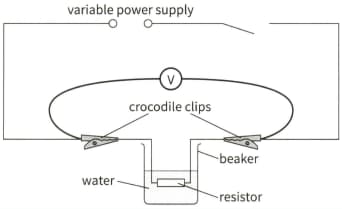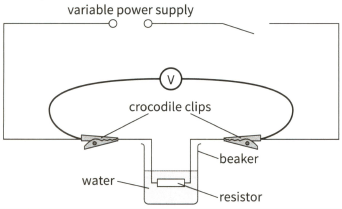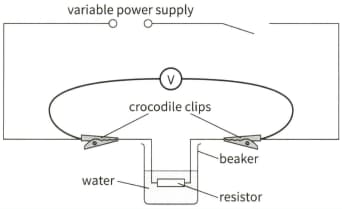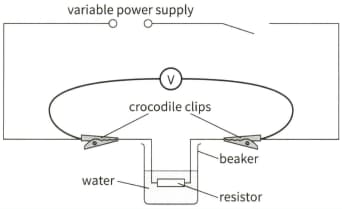David Sang and Graham Jones Solutions for Chapter: Practical Skills at AS Level, Exercise 14: EXAM-STYLE QUESTIONS
David Sang Physics Solutions for Exercise - David Sang and Graham Jones Solutions for Chapter: Practical Skills at AS Level, Exercise 14: EXAM-STYLE QUESTIONS
Attempt the practice questions on Chapter 32: Practical Skills at AS Level, Exercise 14: EXAM-STYLE QUESTIONS with hints and solutions to strengthen your understanding. Physics for Cambridge International AS & A Level Coursebook 3rd Edition Digital Access solutions are prepared by Experienced Embibe Experts.
Questions from David Sang and Graham Jones Solutions for Chapter: Practical Skills at AS Level, Exercise 14: EXAM-STYLE QUESTIONS with Hints & Solutions
A student releases a toy car to roll down a ramp, as shown.

The student measures the distance from the middle of the car as it is released to the bottom of the ramp and the distance travelled along the straight section before the car stops. He also measures the time taken to travel the distance . He then repeats the experiment using a different value of .
The student obtained readings with and , taking each reading for and twice. The readings were:
: values for were ; values for were
values for were ; values for were .
(d) Describe four sources of uncertainty or limitations of the procedure for this experiment.
A student releases a toy car to roll down a ramp, as shown.

The student measures the distance from the middle of the car as it is released to the bottom of the ramp and the distance travelled along the straight section before the car stops. He also measures the time taken to travel the distance . He then repeats the experiment using a different value of .
The student obtained readings with and , taking each reading for and twice. The readings were:
: values for were ; values for were
values for were ; values for were .
(e) Describe four improvements that could be made to this experiment. You may suggest the use of other apparatus or different procedures.
This apparatus shows a resistor in some water.

A student measures the rise in temperature of the water in using two different values of voltage.
The student wrote:
'When the voltage was set at , the rise in temperature of the water in was . The voltmeter reading decreased by about during the experiment, and so the final voltmeter reading was . 'The reading fluctuated from time to time by about . The smallest scale division on the thermometer was , but I could read it to . I did not have time to repeat the reading.
'When the voltage was set at , the rise in temperature in was and the voltage was almost the same at the end, but fluctuated by about ''
(a) Estimate the percentage uncertainty in the measurement of the first voltage.
This apparatus shows a resistor in some water.

A student measures the rise in temperature of the water in using two different values of voltage.
The student wrote:
'When the voltage was set at , the rise in temperature of the water in was . The voltmeter reading decreased by about during the experiment, and so the final voltmeter reading was . 'The reading fluctuated from time to time by about . The smallest scale division on the thermometer was , but I could read it to . I did not have time to repeat the reading.
'When the voltage was set at , the rise in temperature in was and the voltage was almost the same at the end, but fluctuated by about ''
(b) It is suggested that is related to according to the formula , where is a constant.
(i) Calculate two values for k. Include the units in your answer.
This apparatus shows a resistor in some water.

A student measures the rise in temperature of the water in using two different values of voltage.
The student wrote:
'When the voltage was set at , the rise in temperature of the water in was . The voltmeter reading decreased by about during the experiment, and so the final voltmeter reading was . 'The reading fluctuated from time to time by about . The smallest scale division on the thermometer was , but I could read it to . I did not have time to repeat the reading.
'When the voltage was set at , the rise in temperature in was and the voltage was almost the same at the end, but fluctuated by about ''
(b) It is suggested that is related to according to the formula , where is a constant.
(ii) Justify the number of significant figures you have given for your value of .
This apparatus shows a resistor in some water.

A student measures the rise in temperature of the water in using two different values of voltage.
The student wrote:
'When the voltage was set at , the rise in temperature of the water in was . The voltmeter reading decreased by about during the experiment, and so the final voltmeter reading was . 'The reading fluctuated from time to time by about . The smallest scale division on the thermometer was , but I could read it to . I did not have time to repeat the reading.
'When the voltage was set at , the rise in temperature in was and the voltage was almost the same at the end, but fluctuated by about ''
(b) It is suggested that is related to according to the formula , where is a constant.
(iii) Explain whether the results support the suggested relationship.
This apparatus shows a resistor in some water.

A student measures the rise in temperature of the water in using two different values of voltage.
The student wrote:
'When the voltage was set at , the rise in temperature of the water in was . The voltmeter reading decreased by about during the experiment, and so the final voltmeter reading was . 'The reading fluctuated from time to time by about . The smallest scale division on the thermometer was , but I could read it to . I did not have time to repeat the reading.
'When the voltage was set at , the rise in temperature in was and the voltage was almost the same at the end, but fluctuated by about ''
(C) Describe four sources of uncertainty or limitations of the procedure for this experiment.
This apparatus shows a resistor in some water.

A student measures the rise in temperature of the water in using two different values of voltage.
The student wrote:
'When the voltage was set at , the rise in temperature of the water in was . The voltmeter reading decreased by about during the experiment, and so the final voltmeter reading was . 'The reading fluctuated from time to time by about . The smallest scale division on the thermometer was , but I could read it to . I did not have time to repeat the reading.
'When the voltage was set at , the rise in temperature in was and the voltage was almost the same at the end, but fluctuated by about ''
(d) Describe four improvements that could be made to this experiment. You may suggest the use of other apparatus or different procedures.
